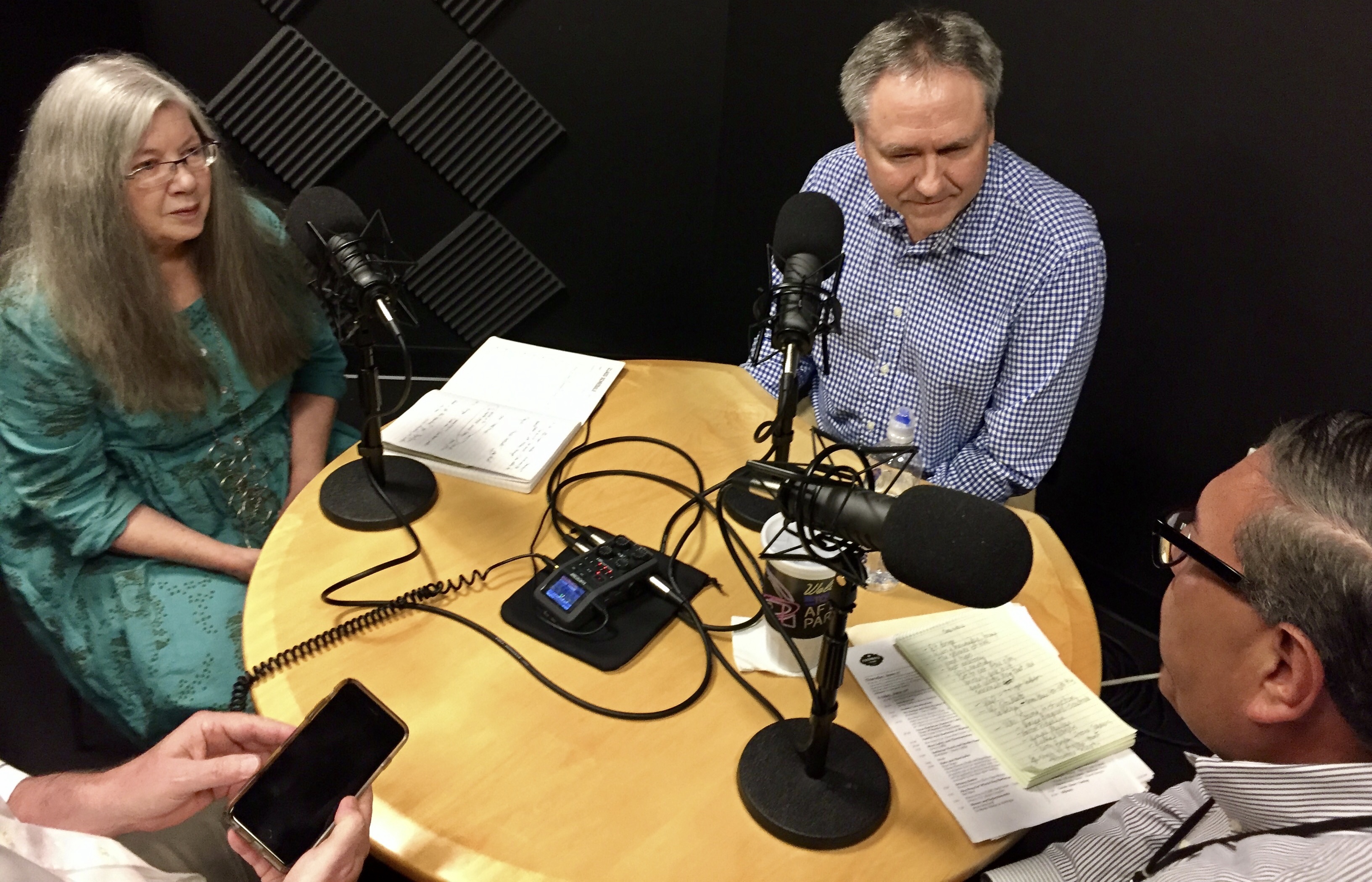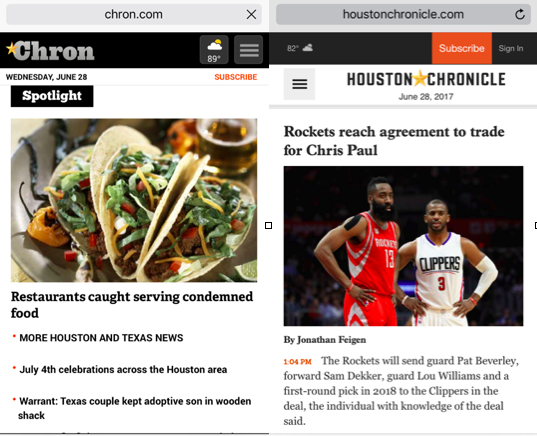HOUSTON — “Wwwwwelcome to the BBQ State of Mind podcast,” J.C. Reid said into a mic in the corner of the video studio at the Houston Chronicle. “My name is…”
“Can we do that one more time without quite so much ‘welcome?’” Scott Kingsley interrupted. The director of multimedia and the podcast’s producer adjusted the mic levels as the other two journalists in the dark, sound-proofed studio burst into laughter.
“Oh, OK,” said Reid, the Chronicle’s barbecue columnist. “I never know.”
Even though Kingsley’s been producing podcasts for the Chronicle for the past year, BBQ State of Mind is still new for Reid, food editor Greg Morago and restaurant critic Alison Cook.
This podcast is the fourth and newest for the Chronicle, and it’s part of a strategy to build more niche audiences, turn them into loyalists and, eventually, digital subscribers.
Editors here describe the Chronicle as a profitable news organization, though they declined to share specific figures. Sunday print subscribers are around 300,000, and the bulk of its revenue still comes from print ad sales.
“While we are blessed with abundant print advertising, still, it shrinks a little bit every year, which is scary,” said Vernon Loeb, the Houston Chronicle’s managing editor.
They’re now facing that reality with three strategies: build niche audiences, teach the newsroom to understand and care about analytics and use both to turn readers into subscribers.

From left, Alison Cook, J.C. Reid and Greg Morago film the third episode of the Houston Chronicle’s BBQ podcast. (Photo by Kristen Hare/Poynter)
‘What fresh hell is this?’
Nancy Barnes has an image of her first day as editor in chief at the Houston Chronicle. It’s not just a memory. A staff photographer took a photo and gave her a copy.
In it, Barnes stands at the confluence of messy gray newsroom cubicles. Chronicle journalists around her look up from their desks. Some stand in the background, arms crossed or hands on their hips. None of them look happy.
The Chronicle, by 2013, had been through major cuts. Whole floors of its downtown headquarters sat empty.
“At that point we’d been through a lot,” said Lisa Gray, editor for the Chronicle’s web magazine Gray Matters, which emphasizes a sense of place and smart conversations. “No change could be good is what you’re seeing on those faces.”
Also on their minds at the time: “What fresh hell is this?” Gray said.
At its largest, the newspaper of the United States’ fourth-biggest city had 480 people in the newsroom. When Gray started here in 2005, the internal phone list filled a page front and back. For years, the type kept getting bigger while the list got smaller.
When Barnes came from the Minneapolis Star Tribune in 2013, the Chronicle had less than 200 employees. That year, Loeb joined from The Washington Post as managing editor. In 2016, the Chronicle left its downtown building for a spot closer to midtown that once housed the Houston Post. (For more, check out the newsroom tour video at the end of the story.)
Among the things Barnes tackled early on was realigning resources in the newsroom. After the layoffs and buyouts, there were a lot of editors left, Barnes said, but not enough reporters. They added a person to the Austin bureau. They brought on people to cover federal courts and immigration. And they cut some high-paying jobs to make space for more reporters.
In all, Barnes has hired 100 people. The newsroom currently numbers about 200.
Barnes often tells her staff that the pace of change in this industry is both exhilarating and exhausting. When she became editor at the Star Tribune in 2007, people said it was the toughest time the industry would face.
“It really wasn’t,” Barnes said. “Trust me it wasn’t. But the digital change is accelerating now, and we have to get ahead of it or at least catch up to it.”

Nancy Barnes at the Houston Chronicle on September 18, 2013. (Photo by Michael Paulsen, Houston Chronicle)
‘You pick the tools you want to use.’
The Houston Chronicle came up with their new strategies as part of this year’s Knight-Lenfest Newsroom Initiative. (Disclosure: That program funded my job. See the end of this piece for more details.) Last year, that project worked with newsrooms in Dallas, Miami, Minneapolis and Philadelphia through a process designed to accelerate change and digital adaption.
This year’s group again includes Philadelphia, as well as the Houston Chronicle, The Seattle Times, The (San Jose) Mercury News and the Milwaukee Journal Sentinel.
For participants in Houston, there was a lightbulb moment recently when the program’s facilitators shared a diagram of a snowman. The snowman’s head is the vision. The snowman’s belly is the strategy. The snowman’s bottom is the tools.
For years, Loeb said, the Chronicle had been building one-third of a snowman.
“We provided a lot of digital training for people, intensive two-week modules, video technology, data, social media, and none of it took,” he said. “They got all the training and then they went back and returned to their print-centric lives. We had given them the bottom ball of the snowman without the upper two balls, the strategy or the mission.”
Now, an analytics group has metrics for each member of the staff. Everyone has access to both Omniture for a pulled-back look at analytics and Chartbeat for a look in real-time. And in meetings with each desk, they were all given the job of growing their numbers.
“Everyone has a baseline where they are currently, and their goal is to increase audience by 50 percent over the next six months,” Loeb said.
He hopes two-week morning shifts with Chron.com’s breaking news hub will result in three behavior changes throughout the newsroom:
- People will publish more in the morning.
- They’ll focus on social media and use those platforms to expand their audiences.
- They’ll package their work in a way that helps it do well online.
“Our problem the first time around was we gave you the tools without any strategy or any context,” Loeb said. “Now we’re basically giving you the strategy and the context. You pick the tools you want to use.”
For Maria Carrillo, a senior editor, the approach makes a lot of sense. Carrillo, who came to the Chronicle in 2014, saw a lot of digital preaching but no overarching digital strategy.
“Now the goal is, OK, use your journalism to inspire people to connect,” she said. “That makes perfect sense.”

The Houston Chronicle has four podcasts so far.
‘The people, the places, the deals, the dirt’
Three years after launching Gray Matters, the experiment with smart digital journalism on houstonchronicle.com publishes about three stories a day from journalists across the newsroom as well as outside contributors. “Gray Matters” stories consistently rank among houstonchronicle.com’s top 10 stories, Gray said.
“I once published an equation that did really well online,” she said. “That cracked me up.”
She’s now part of the Chronicle’s niche strategy team. One of the keys, she said, is realizing that not everyone has to do everything. Now, they’re trying to figure out: Who’s good at podcasts? Who can shine with a newsletter? What tools work with each specific journalist?
Nancy Sarnoff, a real estate reporter, hosts Looped In, a podcast she launched with colleague Erin Mulvaney last June. “Looped In,” tells the stories of “the people, the places, the deals, the dirt,” and has 44 episodes to date.
In June, “Looped In” won an award from the National Association of Real Estate Editors.
“This allows me to tell stories in a different way,” said Sarnoff, who started at the Chronicle in 2004. “It’s really fun being on the leading edge of something.”
Not that podcasts are the leading edge anymore, she added.
“But they are here.”
‘People who live here in this city don’t even know there’s a second web site’
Did you know the Chronicle has two sites?
Chron.com, its first site, is free and focuses on breaking and viral news. Houstonchronicle.com was, until very recently, behind a hard paywall. It’s now metered.
“People who live here in this city don’t even know there’s a second website,” Carrillo said.
The two sites also have separate staffs. Andrea Mooney, Chron.com’s executive producer, reports directly to Hearst, the Chronicle’s parent company. The two-site strategy is in place at Hearst papers around the country.
The theory behind the two-site strategy was that the paid site would be for people who loved the newspaper experience and wanted deeper dives, Loeb said. The free site would build a big audience and ad revenue base and drive subscriptions toward the paid site.
In practice, that’s not what’s happened.
Hearst’s corporate strategy is now changing across the United States. The hard paywall is down on houstonchronicle.com, replaced with a three-story meter. Both sites will track people’s reading habits and customize their homepage experiences based on what they’re coming for. The hope is that the free site will better funnel regular users into digital subscribers.
But even if that works, there’s still an identity issue and clear divisions between the two staffs.
“They’re looking for loyal readers any which way,” Carrillo said. “What’s the best strategy for us? I think in the newsroom it would feel good to be united, to not feel like we are somehow at cross-purposes.”
This newsroom has to learn how to balance the buzz with work that has major social impact.
“They need each other,” Gray said.

The mobile sites of Chron.com left, and HoustonChronicle.com, right, at the same time on Wednesday, June 28, 2017.
‘Change takes time.’
More than a year ago, Lydia DePillis got a call from Loeb. Had she ever thought of coming to Texas, he asked?
She hadn’t. At the time, DePillis was at The Washington Post. She’d been feeling restless for awhile. So she came to Houston, and “I found a place that was in the process of reinventing itself.”
Things were changing from one day to the next. Staff was taking on big projects. But from the start, it wasn’t clear whose job it was to think about how stories looked online.
As the Chronicle works to develop digital habits that connect with their digital strategy, there are still some print processes getting in the way here, DePillis said. Those print processes, including newspaper-style headlines and no thought for visuals, may be changing as people get to understand metrics and strategy.
Some other challenges that still remain:
- Mornings — While the features team now starts their days at 7:30 a.m., most of the rest of the newsroom doesn’t. Obviously, you can’t post stories online early if you’re coming in late.
- The mushy middle — Many editors have cut back on mid-length stories, and that needs to happen here, too, Carrillo said. “We’re in a world where we really are about the quick hit and the deep dive.”
- Holding everyone accountable — “I worry a lot about focus and the term I use all the time now, accountability,” Mooney said. If people are supposed to post more and come in earlier and explore new tools, what happens if they don’t? “Change takes time,” she said. “We’re trying to make it happen faster. But it takes time. Success will help make that go faster.”
Editors hold up the Chronicle’s “Denied” series as an example of what’s possible. The investigation into special education was a Pulitzer Prize finalist. It looked beautiful both online and in print, Gray said, and the online team was involved from the beginning.
Rachael Gleason came to the Chronicle one year ago and has watched the evolution of the new approach. Gleason, a data journalist and producer, said there are a lot of challenges with the two-site strategy. But now, the newsroom seems to be in agreement about how important digital is, and they have the tools to help them get there.
“I feel like we’re on the right track,” she said, “and we still have so much work ahead of us.”
‘Literally you can major in meat…’
In the closed-off corner of the Chronicle’s video studio, the BBQ State of Mind recording continued. Reid un-welcomed his welcome a bit then fell into an insider’s chat on the joys and trials of barbecue.
“People don’t realize that at Texas A&M, literally, you can major in meat…,” Reid said.
“…Yeah, PhDs in meat science,” Morago said.
“It’s amazing.”
Kingsley, the multimedia editor, listened through headphones. He’d love to create more produced podcasts, but they can’t keep adding more and more to people’s work.
They have to pick something, like this, and be really, really good at it, he said.
Kingsley left the industry in 2009 when he was laid off from the Providence Journal. He figured that was it. Then, two years ago, he found himself in Houston interviewing at the Chronicle.
In the back of his mind, he thought, “Moving to Texas? Are you kidding me?”
But he found a place that felt different than what he’d left.
In his interview, Loeb set his lure for Kingsley expertly.
Loeb said, “you know, some people are up for an adventure and some aren’t,” Kingsley remembered.
As he headed for the airport, Kingsley thought about that. And, he realized, he was surprised how much he was interested in returning to journalism. There were a lot of reasons not to come back — family, relocating, an industry in constant churn.
But he, like a lot of people here, was up for the adventure.
Editor’s note: Kristen Hare’s position covering local innovation is funded by the Knight-Lenfest Newsroom Initiative. In addition to regular coverage, teaching and a newsletter, the grant calls for Hare to revisit the newsrooms in last year’s group and visit the newsrooms in this year’s group to report on what’s working, what’s not and lessons learned. Poynter maintains complete editorial independence in the process.







